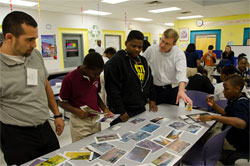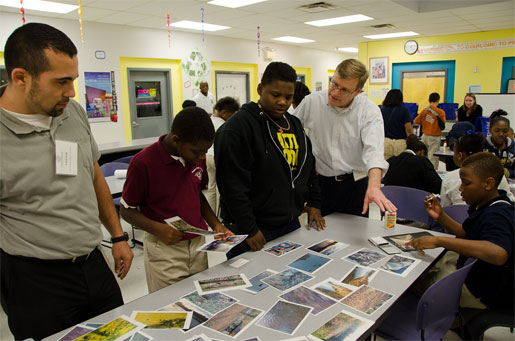
Kids Go Green with EPA Partnership Programs
- By Elizabeth Freed
- Mar 16, 2012
After much success in pilot projects like the Boys & Girls Club of America (BGCA) in Kansas City, the U.S. Environmental Protection Agency (EPA) has decided to fund a national partnership program with BGCA on children’s environmental health.
“The Boys & Girls Clubs of America is a national organization devoted to youth development programs and services for kids from communities and socio-economic situations that need youth services the most,” said Peter Grevatt, Director of Children’s Health Protection and Environmental Education. “BGCA provides programs to more than four million youth each year that focus on health, fitness, and nutrition, as well as educational enhancement, civic engagement, and character and leadership development.”
The educational programming was tested at the Kansas City, Kan. and Mo., BGCA for two years before the EPA Office of Children’s Health Protection and Environmental Education decided to launch the curriculum nationally.

The Thornberry Boys and Girls Club and the USEPA Region 7 Urban Waters Team engage in a project during the Environmental Justice Awareness Program.
“The kids love it,” said Penney King, Vice-President of Operations for the BGCA in Kansas City. “It’s been an awesome partnership both personally and professionally.”
King reports that her two children who attended the summer portion of the BGCA/EPA program have turned into “green queens” at home, encouraging mom to turn out the lights and save energy. Five Boys & Girls Clubs in Kansas City are participating in the EPA curriculum on both sides of the state line.
The environmental health curriculum consists of nine 45-minute sessions. These include: Environmental Health 101; Pesky Pests and Household Hazards; Breathing Easy: Keeping the Inside of Our Homes Healthy and Clean; Be Sun Smart; Climate Change and You; Healthy Water Inside; Keeping All of Our Waterways Clean; Sustainable Eating, Healthy Foods, and Community Gardens; and All Together Now – Air, Water, Food, and Shelter.
The sessions are designed for middle school students and contain packages with materials and syllabi. Each lesson has a hands-on activity and information materials that can be brought home to inspire improvements.
“BGCA is positioned to reach out and equip families, especially in disadvantaged areas, with information to protect the environmental health of children and their communities,” said Grevatt. “EPA’s Office of Children’s Health Protection has partnered with BGCA to introduce children’s environmental health information into the educational programs provided by BGCA.”
A $100,000 grant from the EPA’s Office of Children’s Health Protection will help fund the expansion of the educational curriculum nationally. One cycle of the program is currently underway and will last until March 26. A second section is scheduled for the summer.

USEPA Region 7 hosts Thornberry and Hawthorne Boys and Girls Club at the Training and Logistics Center, to closeout the Environmental Justice Awareness Program on December 22, 2011. During the visit, the students enjoyed a tour, demonstrations and presentations by Region 7 staff.
At the BGCA in Kansas City, several projects have sprung up as a result of the ongoing partnership with the EPA. The enrolled children have replanted trees and made rain barrels. They continue to help with community gardens at two different sites. Even in the office, staffers are recycling paper and going green.
One of the best improvements in the program, King said, is the teach-back leadership addition. In this component, older middle school students teach younger students what they have learned. This has multiple benefits. Older students feel empowered to teach, which solidifies the knowledge they have accumulated. Younger students are introduced to new concepts and feel engaged by their older peers.
According to the EPA’s Office of Children’s Health Protection, middle school students are developmentally at an ideal age for discussions of environmental issues and health because they are both fascinated by and able to comprehend large-scale systems and their place within such systems. Young people at this age are also focused on their ability to make changes in their world, the office reported.
Content about the solar system, ozone, and UV rays has been added this year to enhance the program’s subject material. King said that the kids love the subject matter about space, and that information about UV rays helps children learn about cultural differences.
For example, she said, the Caucasian kids will ask the African-American kids if they really need sunscreen. The African-American students themselves doubted the necessity for SPF on their skin. However, by learning about the deteriorating effects of UV rays, they learned to say, “Yes, we need it because UV is harmful to all types of skin.”

The Thornberry Boys and Girls Club and the USEPA Region 7 Urban Waters Team engage in a project during the Environmental Justice Awareness Program.
Children and young adults could be the most important audience for environmental health education because they bring pressure home to get green and clean. This can improve the lifestyle for the whole family, which is an integral part of bringing about widespread change in the community.
“EPA and BGCA have partnered for purposes of creating and empowering champions for children’s environmental health in their homes, schools and communities,” said Grevatt. “This cooperation should enhance the protection of children’s environmental health as well as build healthier communities.”
The EPA continues to build patnerships with other organizations that focus on children as their primary audience. For example, Scholastic Inc. will soon release a Spanish-language version of “The Magic School Bus Gets Cleaned Up.” The Magic School bus series has been educating and entertaining young people about science for the last 25 years.
“'The Magic School Bus Gets Cleaned Up' makes the science of clean air fun,” said Gina McCarthy, assistant administrator for EPA’s Office of Air and Radiation. “Translating the book into Spanish is an opportunity to engage new audiences.”
“El Autobus Mágico – Necesita Una Limpieza” will help the EPA reach the almost 37 million people living in the United States who speak Spanish as their primary language at home. In the book, the children and their science teacher Ms. Frizzle explore the pollution emitted from their own diesel school bus and learn how to reduce the emissions while travelling through a diesel engine.
Since 2008, the EPA has retrofitted, replaced, or repowerd over 20,000 school buses through the Diesel Emissions Reduction Program. Buses built since model year 2007 are 60 times cleaner tha a pre-1990 bus, reducing air pollution and incidental causes of respiratory ailments like asthma. Even the Traveling Magic School Bus gets retrofitted in the book, which was originally released in 2007.
“Scholastic is thrilled to continue to work with the EPA in its effort to educate all children and their families about clean air,” said Leslye Schaefer, Senior Vice President of Scholastic Media.
Gearing programming to children is important, the Office of Children’s Health stated, because children may be more vulnerable to environmental exposure than adults. Children’s bodily systems are still developing; they eat, drink, and breathe more in proportion to their body size; and their behavior can expose them to more chemicals and organisms.
Resources about environmental safety and health for community groups and schools can be found at: http://yosemite.epa.gov/ochp/ochpweb.nsf/content/Whatwe_educat.htm
About the Author
Elizabeth Freed is an Associate Content Editor for 1105 Media Inc.